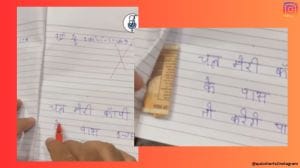- India
- International
What is Koo app, the Indian alternative to Twitter, and how do you use it?
Koo App: Koo, another Indian version of Twitter, has gained some prominent followers in the recent days, including Ministers Ravi Shankar Prasad, Piyush Goyal and Madhya Pradesh chief minister Shivraj Singh Chauhan.
 Koo app is the new favourite for Indian Twitter users, who appearing to be flocking there.
Koo app is the new favourite for Indian Twitter users, who appearing to be flocking there. Koo, another Indian version of Twitter, has gained some prominent followers in the recent days, including Ministers Ravi Shankar Prasad, Piyush Goyal and Madhya Pradesh chief minister Shivraj Singh Chauhan. Koo’s rise comes as Twitter is currently engaged in a standoff with the Indian government over the blocking and unblocking of accounts linked to the farmer protests.
“We started working on this app since November 2019. We wanted to get the voice of Indian language speakers on the internet. Existing platforms focus on the 1 per cent who speak in English. We launched in March 2020, which coincided with COVID,” Aprameya Radhakrishna, CEO and co-founder for Koo told indianexpress.com over a call.
While RS Prasad already has a verified handle on Koo and joined the app in February, Goyal announced on Twitter that he was also present on Koo, and asked his followed to “exchange our thoughts and ideas on Koo”. Chauhan also tweeted saying he was present on the Koo website. Not just ministers, even departments such as Telecom, IT, India Post, Central Board of Indirect Taxes and Customs, and MyGovIndia, are also present on Koo. Isha Foundation’s Jaggi Vasudev, former cricketers Javagal Srinath and Anil Kumble have also joined the platform.
But what is Koo and how does it work? We take a quick look
What is Koo?
Koo is a micro-blogging platform just like Twitter. It is available as a website and on iOS and Google Play Store. You can post opinions on Koo publicly and follow other users as well. A feed shows posts from other users. The character limit for a ‘Koo’ is 400. One can sign up for Koo using their mobile number. Users have the option of linking their Facebook, LinkedIn, YouTube and Twitter feed to the Koo profile as well.

One can also post audio or video-based posts. A ‘Koo’ also lets users rely on hashtags, which is similar to Twitter. A user can also tag another person in their posts using the @ symbol, which is again similar to Twitter. There’s also the option to post polls, share photos and videos on Koo.
Who has developed or created Koo?
Koo has been created by Bombinate Technologies Private Limited which is a Bangalore-based private company incorporated in 2015. According to details, the company is involved in “other computer-related activities [for example maintenance of websites of other firms/ creation of multimedia presentations for other firms etc.]”
The Koo app won the Atmanirbhar App Innovation Challenge along with other India-made apps like Zoho and Chingari — the local version of TikTok. The co-founder and CEO of Koo app is Aprameya Radhakrishna, who according to his LinkedIn profile has an MBA degree from IIM, Ahmedabad and an engineering degree from the National Institute of Technology, Karnataka. The app has seen over 3 million downloads as of now, according to the CEO.
What is special about Koo?
Koo is an India-based app and focuses on allowing people to post in their language. When you are signing up, it lets you choose from Indian languages at the time of setup. However, you can only choose one language. For instance, I could not pick both Hindi and English as an option. The languages supported at the moment are English, Hindi, Kannada, Telugu, Tamil Marathi, Bengali, Malayalam, Oriya, Punjabi, Assamese, and Gujarati.
According to Radhakrishna, users will be able to find topics around their language of choice, follow people in their spoken language. He also explained that because typing in regional languages can be painful for Indian users, the app has an option for audio and video posts to make things simpler.
He also confirmed that at any one point, the app will provide a single language experience for users.
The Koo website notes that only 10 per cent of India speaks English and “almost 1 billion people in India don’t know English.” The website adds that the “majority of the internet has been in English. Koo is an attempt to make the voice of these Indians heard. They can now participate on the internet in their mother tongue by listening to the views of some of the sharpest Indian minds and also speak their mind by sharing their thoughts.”
What are the content policies on Koo?
‘We are a free expression platform. There will be exceptions when there is threat to life, threat of mob violence. Those are things where we will abide by the law of the land,” Radhakrishna said, adding that posts should not cause any harm to someone’s life.
While he said that the app does have a set of policies in place, he added that they will keep briefing up their policies to ensure that users have a safe experience on the platform. When asked whether Koo would ban users who troll others on the platform, he said they have not yet dealt with such scenarios yet and will react as they happen.
When asked whether Koo would benefit from the anti-Twitter stance that is gaining in India, Radhakrishna said, “We started way before anything of this sort was discussed. We have a unique space to go deep into India with languages and we are going with that product approach. It is not an us vs Twitter approach. We are solving for Indian language users.”
Is Koo the only alternative to Twitter?
No. Previously we saw the Tooter app from India gain popularity briefly in November last year. Tooter also presented itself as a ‘Swadeshi’ alternative to the Twitter app, though it was very heavily inspired by the original ‘videshi‘ app. Tooter had also seen ministers from the government joining the app, but it doesn’t look like they stuck around for too long.
There was also Mastodon, which had gained popularity with Indian Twitter activists back in November 2019. Mastodon has been around since 2016, and while the design is also similar to Twitter, it is an open-source and distributed or federated social network, where anyone can host their own server. Again most people didn’t really stick around to Mastodon and were back on Twitter.
More Tech
Apr 17: Latest News
- 01
- 02
- 03
- 04
- 05







































